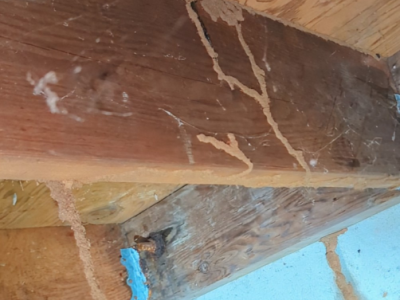Subterranean Termite Infestation
 Subterranean Termites
Subterranean Termites
Subterranean termites live underground and travel through soil and mud tubes to reach the wood above. These mud tubes protect them from predators and dehydration. Unlike drywood termites, subterranean termites don’t live inside the wood they feed on, nor do they consume it entirely. They eat the softer springwood and leave behind the harder heartwood, resulting in wood that’s channelized and packed with mud and droppings.
Subterranean termites swarm in the spring. Swarmers are about a quarter inch long, with dark bodies, dark heads, broad waists, and two pairs of equal-length wings. They resemble drywood termite swarmers but lack the reddish head. Instead of nesting within wood, subterranean termites build their colonies underground. In many parts of the country, they cause far more damage than drywood termites—but in California’s mild climate, drywood termites are more prevalent.
The video below shows a severe subterranean infestation in a homeowner’s crawlspace, most likely caused by a plumbing leak. This home is being fumigated for drywood termites, but fumigation does not control subterranean termites because their colonies are underground. Treating subterranean termites with fumigation is like spraying a trail of ants—it may kill the ones you see, but unless you reach the nest, the colony survives and keeps producing offspring.
The proper way to control subterranean termites is by treating the soil. When termites tunnel through treated soil, they spread the termiticide throughout the colony, eliminating it at the source. Most manufacturers claim that the chemical remains active in the soil for up to eight years, providing long-lasting residual protection.
After treatment, all visible mud tubes and other evidence should be removed. This allows for easy monitoring and ensures old evidence isn’t mistaken for new activity later on. Subterranean termites can be treated locally in targeted areas or through a full perimeter soil treatment for comprehensive protection.
Bait stations, often placed around the home’s perimeter, should generally be avoided. Termites must first locate the stations, which may never happen, and maintaining them usually requires a recurring monthly fee. Soil treatments, on the other hand, are a one-time expense that offer years of residual protection. If you stop paying for bait stations, your protection ends—whereas soil treatments continue working long after the job is done.
John Gelhard


